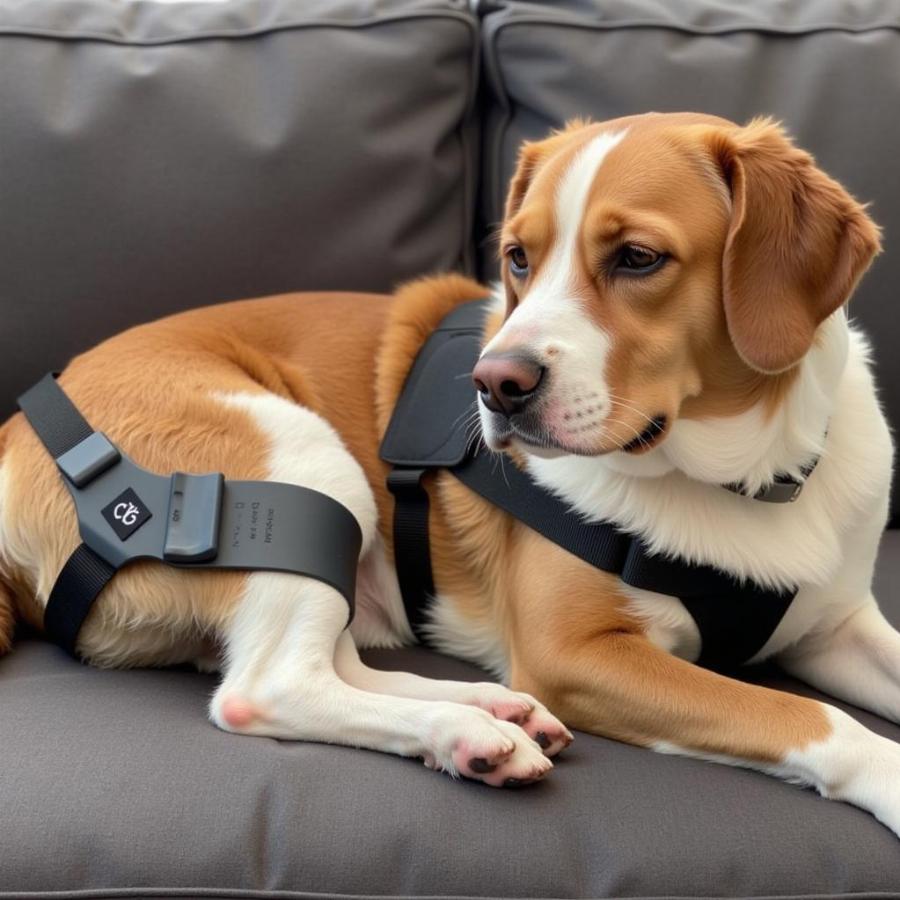A CCL (cranial cruciate ligament) brace for dogs is often recommended after injury or surgery to stabilize the knee joint and aid in recovery. But choosing the right brace and understanding its use can feel overwhelming. This guide provides valuable information about CCL braces, their benefits, types, and how to choose the perfect one for your furry friend. We’ll also delve into post-operative care and frequently asked questions to ensure you have everything you need to support your dog’s healing journey.
Understanding CCL Injuries in Dogs
CCL tears are a common injury in dogs, similar to ACL tears in humans. They can happen suddenly during strenuous activity or develop gradually due to aging or underlying conditions. Symptoms include limping, swelling, pain, and instability in the knee.
Types of CCL Braces for Dogs
Several types of CCL braces are available, each designed for specific purposes and stages of recovery. Understanding the differences can help you make an informed decision.
Functional Braces
These braces provide support and stability during activity, limiting range of motion and reducing strain on the injured knee. They’re often used for dogs with partial tears or during rehabilitation after surgery.
Rehabilitative Braces
Designed for post-operative use, rehabilitative braces offer more control and restriction of movement, promoting healing and preventing re-injury. They can be adjusted as the dog recovers and regains strength.
Prophylactic Braces
Prophylactic braces are used to prevent CCL injuries, especially in dogs participating in high-impact activities or with a history of knee problems.
Choosing the Right CCL Brace for Your Dog
Selecting the right brace depends on several factors, including the severity of the injury, the dog’s size and breed, and their activity level. Consulting with your veterinarian is crucial for proper diagnosis and brace selection.
Factors to Consider
- Severity of the injury: Partial tears may benefit from functional braces, while complete tears often require more restrictive rehabilitative braces.
- Dog’s size and breed: Braces are available in various sizes to ensure a proper fit and optimal support.
- Activity level: Active dogs may need more durable and supportive braces.
Caring for Your Dog with a CCL Brace
Proper care is essential to maximize the benefits of a CCL brace. This includes ensuring a correct fit, monitoring the skin for irritation, and following your veterinarian’s instructions for brace usage and exercise.
Fitting and Adjustment
A properly fitted brace is crucial for comfort and effectiveness. Your veterinarian will demonstrate how to apply and adjust the brace correctly. do dogs get braces
Monitoring and Cleaning
Regularly check the skin under the brace for redness, sores, or irritation. Clean the brace according to the manufacturer’s instructions.
What is the purpose of a CCL brace for dogs?
A CCL brace provides stability to the knee joint, reducing pain and inflammation, and promoting healing. It also helps to prevent re-injury during activity.
How long does a dog need to wear a CCL brace?
The duration of brace usage varies depending on the individual dog and the nature of their injury or surgery. It can range from a few weeks to several months. knee surgery for dogs
Can a CCL brace replace surgery?
In some cases, a CCL brace can be used as a conservative management option for partial tears or in dogs who are not surgical candidates. However, surgery is often the recommended treatment for complete tears. braces for dogs acl
Are there different types of CCL braces?
Yes, as mentioned earlier, there are functional, rehabilitative, and prophylactic braces, each designed for different purposes.
“Choosing the correct CCL brace is a critical decision in a dog’s recovery,” says Dr. Emily Carter, DVM, a certified canine rehabilitation specialist. “A well-fitted brace, coupled with a tailored rehabilitation program, can significantly improve a dog’s mobility and quality of life.”
Living with a Dog in a CCL Brace
Adapting to life with a dog in a CCL brace requires patience and understanding. You may need to adjust your dog’s activity level and provide a supportive environment for healing. dog brace for acl tear
What are some tips for managing a dog with a CCL brace?
- Restrict activity to short, leashed walks.
- Avoid stairs and slippery surfaces.
- Provide a comfortable and supportive bed.
- Monitor the brace for proper fit and cleanliness.
“Remember that each dog’s recovery journey is unique,” adds Dr. Sarah Mitchell, DVM, a specialist in veterinary orthopedics. “Consistent communication with your veterinary team is crucial throughout the process.”
 Dog Resting with CCL Brace
Dog Resting with CCL Brace
Conclusion
A CCL brace can be a valuable tool in managing CCL injuries in dogs. By understanding the different types of braces, choosing the right one for your dog, and providing proper care, you can significantly contribute to their recovery and well-being. Remember to consult with your veterinarian for personalized guidance and support. small dog knee brace
FAQ
- Can my dog swim with a CCL brace?
- How do I clean my dog’s CCL brace?
- Are there any alternatives to CCL braces?
- How much does a CCL brace for dogs cost?
- Can a CCL brace be used for both hind legs?
- How do I know if the brace is fitting correctly?
- What are the signs of a CCL tear in dogs?
Explore More
Looking for more information about dog health and care? Check out our related articles on knee surgery for dogs and other orthopedic conditions.
Beaut Dogs is your trusted source for comprehensive and reliable information about the world of canine companions. We offer a wealth of knowledge on various dog breeds, their care, and their unique needs. From health and nutrition to training and grooming, we cover everything you need to know to be the best pet parent possible. When you need expert guidance, contact us at Email: [email protected] to receive detailed and accurate answers from Beaut Dogs. For more information, visit us at https://beautdogs.com.